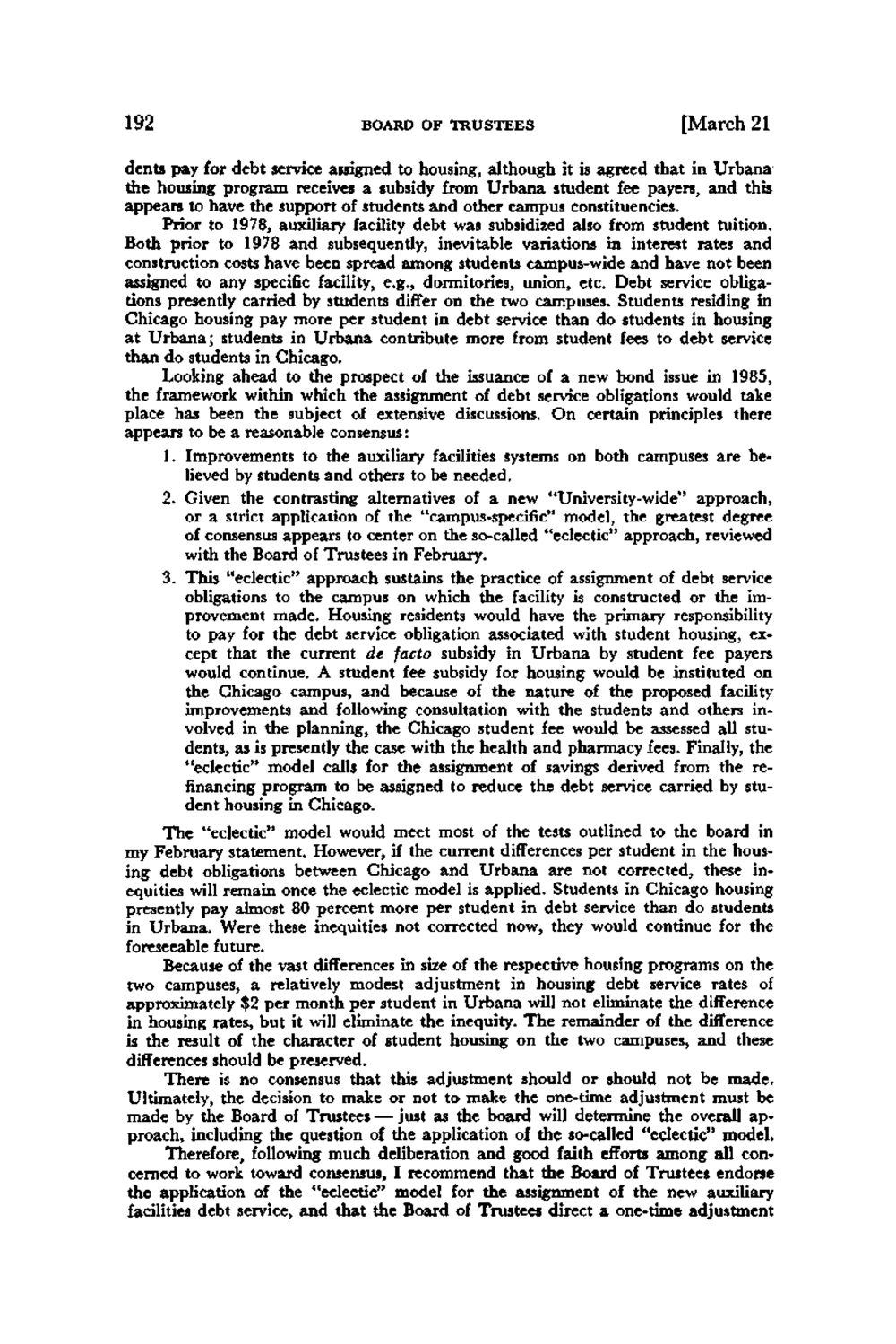| |
| |
Caption: Board of Trustees Minutes - 1986
This is a reduced-resolution page image for fast online browsing.

EXTRACTED TEXT FROM PAGE:
192 BOARD OF TRUSTEES [March 21 dents pay for debt service assigned to housing, although it is agreed that in Urbana the housing program receives a subsidy from Urbana student fee payers, and this appears to have the support of students and other campus constituencies. Prior to 1978, auxiliary facility debt was subsidized also from student tuition. Both prior to 1978 and subsequently, inevitable variations in interest rates and construction costs have been spread among students campus-wide and have not been assigned to any specific facility, e.g., dormitories, union, etc. Debt service obligations presently carried by students differ on the two campuses. Students residing in Chicago housing pay more per student in debt service than do students in housing at Urbana; students in Urbana contribute more from student fees to debt service than do students in Chicago. Looking ahead to the prospect of the issuance of a new bond issue in 1985, the framework within which the assignment of debt service obligations would take place has been the subject of extensive discussions. On certain principles there appears to be a reasonable consensus: 1. Improvements to the auxiliary facilities systems on both campuses are believed by students and others to be needed. 2. Given the contrasting alternatives of a new "University-wide" approach, or a strict application of the "campus-specific" model, the greatest degree of consensus appears to center on the so-called "eclectic" approach, reviewed with the Board of Trustees in February. 3. This "eclectic" approach sustains the practice of assignment of debt service obligations to the campus on which the facility is constructed or the improvement made. Housing residents would have the primary responsibility to pay for the debt service obligation associated with student housing, except that the current de facto subsidy in Urbana by student fee payers would continue. A student fee subsidy for housing would be instituted on the Chicago campus, and because of the nature of the proposed facility improvements and following consultation with the students and others involved in the planning, the Chicago student fee would be assessed all students, as is presently the case with the health and pharmacy fees. Finally, the "eclectic" model calls for the assignment of savings derived from the refinancing program to be assigned to reduce the debt service carried by student housing in Chicago. The "eclectic" model would meet most of the tests outlined to the board in my February statement. However, if the current differences per student in the housing debt obligations between Chicago and Urbana are not corrected, these inequities will remain once the eclectic model is applied. Students in Chicago housing presently pay almost 80 percent more per student in debt service than do students in Urbana. Were these inequities not corrected now, they would continue for the foreseeable future. Because of the vast differences in size of the respective housing programs on the two campuses, a relatively modest adjustment in housing debt service rates of approximately $2 per month per student in Urbana will not eliminate the difference in housing rates, but it will eliminate the inequity. T h e remainder of the difference is the result of the character of student housing on the two campuses, and these differences should be preserved. There is no consensus that this adjustment should or should not be made. Ultimately, the decision to make or not to make the one-time adjustment must be made by the Board of Trustees — just as the board will determine the overall approach, including the question of the application of the so-called "eclectic" model. Therefore, following much deliberation and good faith efforts among all concerned to work toward consensus, I recommend that the Board of Trustees endorse the application of the "eclectic" model for the assignment of the new auxiliary facilities debt service, and that the Board of Trustees direct a one-time adjustment
| |